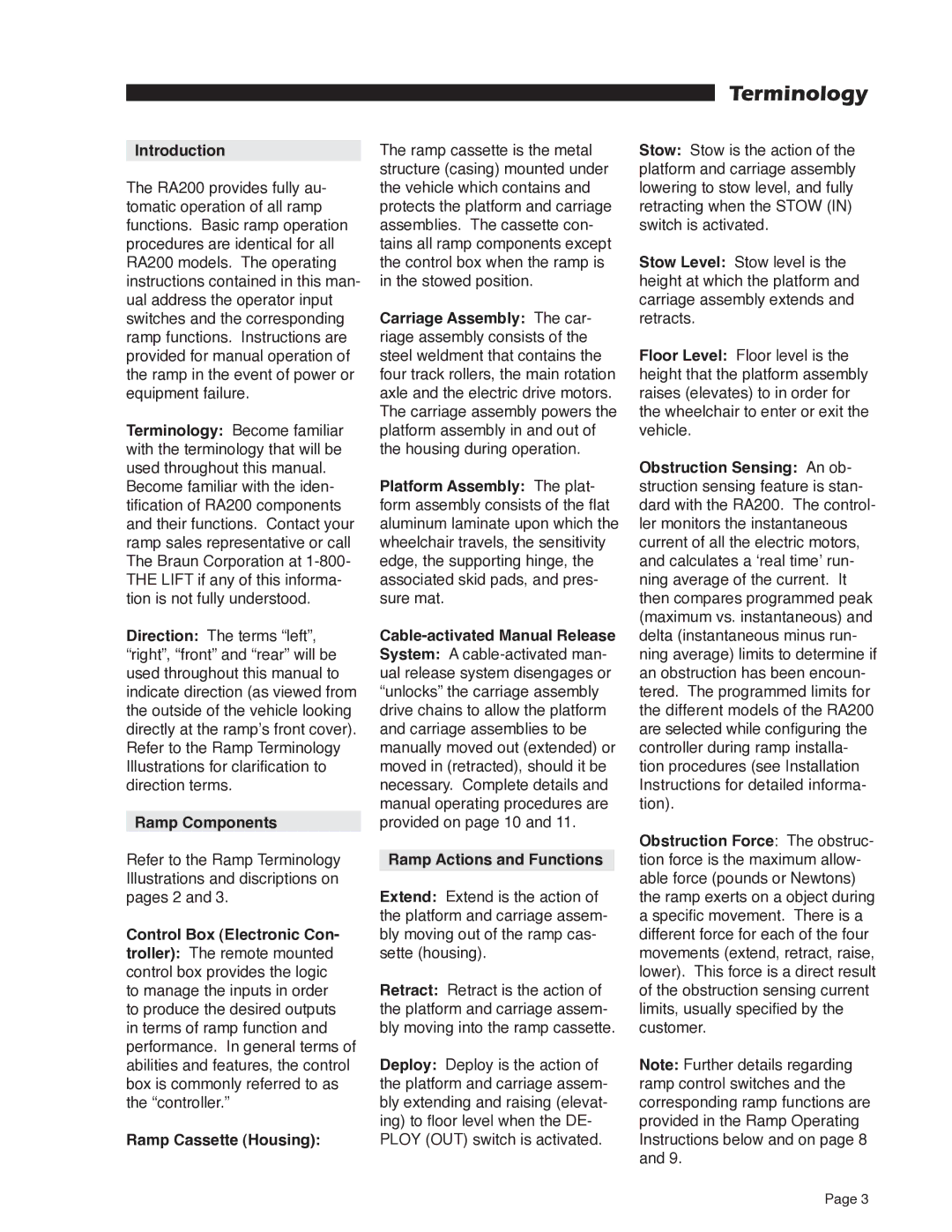
Terminology
Introduction
The RA200 provides fully au- tomatic operation of all ramp functions. Basic ramp operation procedures are identical for all RA200 models. The operating instructions contained in this man- ual address the operator input switches and the corresponding ramp functions. Instructions are provided for manual operation of the ramp in the event of power or equipment failure.
Terminology: Become familiar with the terminology that will be used throughout this manual.
Become familiar with the iden- tification of RA200 components and their functions. Contact your ramp sales representative or call The Braun Corporation at
Direction: The terms “left”, “right”, “front” and “rear” will be used throughout this manual to indicate direction (as viewed from the outside of the vehicle looking directly at the ramp’s front cover). Refer to the Ramp Terminology Illustrations for clarification to direction terms.
Ramp Components
Refer to the Ramp Terminology Illustrations and discriptions on pages 2 and 3.
Control Box (Electronic Con- troller): The remote mounted control box provides the logic to manage the inputs in order to produce the desired outputs in terms of ramp function and performance. In general terms of abilities and features, the control box is commonly referred to as the “controller.”
Ramp Cassette (Housing):
The ramp cassette is the metal structure (casing) mounted under the vehicle which contains and protects the platform and carriage assemblies. The cassette con- tains all ramp components except the control box when the ramp is in the stowed position.
Carriage Assembly: The car- riage assembly consists of the steel weldment that contains the four track rollers, the main rotation axle and the electric drive motors. The carriage assembly powers the platform assembly in and out of the housing during operation.
Platform Assembly: The plat- form assembly consists of the flat aluminum laminate upon which the wheelchair travels, the sensitivity edge, the supporting hinge, the associated skid pads, and pres- sure mat.
Ramp Actions and Functions
Extend: Extend is the action of the platform and carriage assem- bly moving out of the ramp cas- sette (housing).
Retract: Retract is the action of the platform and carriage assem- bly moving into the ramp cassette.
Deploy: Deploy is the action of the platform and carriage assem- bly extending and raising (elevat- ing) to floor level when the DE- PLOY (OUT) switch is activated.
Stow: Stow is the action of the platform and carriage assembly lowering to stow level, and fully retracting when the STOW (IN) switch is activated.
Stow Level: Stow level is the height at which the platform and carriage assembly extends and retracts.
Floor Level: Floor level is the height that the platform assembly raises (elevates) to in order for the wheelchair to enter or exit the vehicle.
Obstruction Sensing: An ob- struction sensing feature is stan- dard with the RA200. The control- ler monitors the instantaneous current of all the electric motors, and calculates a ‘real time’ run- ning average of the current. It then compares programmed peak (maximum vs. instantaneous) and delta (instantaneous minus run- ning average) limits to determine if an obstruction has been encoun- tered. The programmed limits for the different models of the RA200 are selected while configuring the controller during ramp installa- tion procedures (see Installation Instructions for detailed informa- tion).
Obstruction Force: The obstruc- tion force is the maximum allow- able force (pounds or Newtons) the ramp exerts on a object during a specific movement. There is a different force for each of the four movements (extend, retract, raise, lower). This force is a direct result of the obstruction sensing current limits, usually specified by the customer.
Note: Further details regarding ramp control switches and the corresponding ramp functions are provided in the Ramp Operating Instructions below and on page 8 and 9.
Page 3
